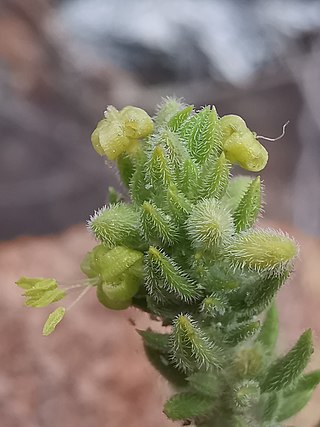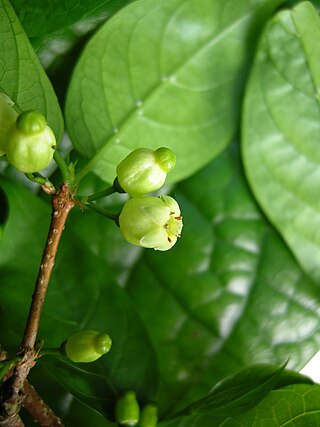
The Rubiaceae are a family of flowering plants, commonly known as the coffee, madder, or bedstraw family. It consists of terrestrial trees, shrubs, lianas, or herbs that are recognizable by simple, opposite leaves with interpetiolar stipules and sympetalous actinomorphic flowers. The family contains about 13,500 species in about 620 genera, which makes it the fourth-largest angiosperm family. Rubiaceae has a cosmopolitan distribution; however, the largest species diversity is concentrated in the tropics and subtropics. Economically important genera include Coffea, the source of coffee, Cinchona, the source of the antimalarial alkaloid quinine, ornamental cultivars, and historically some dye plants.

Anthospermum is a genus of flowering plants in the family Rubiaceae. It is found in Tropical and Southern Africa, Madagascar and in southwestern Arabian Peninsula.

Canthium is a genus of flowering plants in the family Rubiaceae. They are shrubs and small trees. The leaves are deciduous and the stems are usually thorny.

Lagynias was a genus of flowering plants in the family Rubiaceae but is no longer recognized. In 2005, it was sunk into synonymy with Vangueria, based on a phylogenetic study of DNA sequences.

Leptactina is a genus of flowering plants in the family Rubiaceae. There are about 27 species. They are all native to sub-Saharan Africa, where most occur in rainforest habitat.
Multidentia is a genus of flowering plants in the family Rubiaceae.

Pavetta is a genus of flowering plants in the family Rubiaceae. It comprises about 360 species of trees, evergreen shrubs and sub-shrubs. It is found in woodlands, grasslands and thickets in sub-tropical and tropical Africa and Asia. The plants are cultivated for their simple but variable leaves, usually opposite but also occur in triple whorls. The leaves are often membranous with dark bacterial nodules. Pavetta has small, white, tubular flowers, sometimes salviform or funnel-shaped with 4 spreading petal lobes. The flowers are carried on terminal corymbs or cymes.

Rytigynia is a genus of flowering plants in the family Rubiaceae. It is found in tropical and southern Africa. The genera Rytigynia and Fadogia form a strongly supported clade but neither of these genera is monophyletic.
Sericanthe is a genus of flowering plants in the family Rubiaceae. It is found in tropical and subtropical Africa. The genus was described by Elmar Robbrecht in 1978 based on the species in Neorosea, except for the type species, Neorosea jasminiflora, which went to Tricalysia. Bacterial leaf nodules are found in most of the species and the endophytic bacteria have been identified as Burkholderia.

Tricalysia is a genus of flowering plants in the family Rubiaceae. The genus is found in tropical and southern Africa and on the islands in the Western Indian Ocean.

Vanguerieae is a tribe of flowering plants in the family Rubiaceae and contains about 655 species in 30 genera. It is one of the most species-rich groups within the family and it is distributed across the Paleotropics.

Fadogia is a genus of flowering plants in the family Rubiaceae. The genera Rytigynia and Fadogia form a strongly supported clade but neither of these genera is monophyletic.

Canthium armatum is a species of flowering plants in the family Rubiaceae. It is a shrub or tree native to southern Mozambique, Eswatini, and KwaZulu-Natal and the Northern Provinces of northeastern South Africa. The species is characterized by the presence of large spines.
Fadogiella is a small genus of flowering plants in the family Rubiaceae. It was described by Walter Robyns in 1928.
Vangueriella is a genus of flowering plants in the family Rubiaceae. The genus is found in tropical Africa.
Cuviera is a genus of flowering plants in the family Rubiaceae native to tropical Africa. It was originally described by Augustin Pyramus de Candolle in 1807 and is named after the French naturalist Georges Cuvier.
Globulostylis is a genus of flowering plants in the family Rubiaceae. It comprises 8 species growing in Central Africa.

Vangueria pygmaea is a species of flowering plant in the family Rubiaceae.












